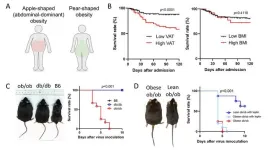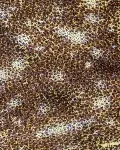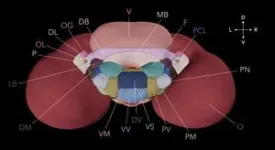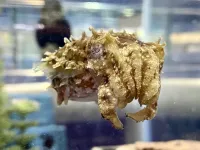When it comes to COVID-19, belly fat upsets the apple cart
2023-06-20
(Press-News.org)
Researchers from Tokyo Medical and Dental University (TMDU) find that apple-shaped obesity is associated with cytokine storm and a higher risk of death in COVID-19 patients
Tokyo, Japan – Eating an apple a day may keep the doctor away, but having an apple shape is not nearly as healthy. Now, researchers from Japan have shown that people who carry their weight in their bellies may be at greater risk of poor outcomes if they catch COVID-19.
In a study published last month in Proceedings of the National Academy of Sciences (PNAS), researchers from Tokyo Medical and Dental University (TMDU) revealed that carrying excess belly fat is related to greater inflammation and mortality in Japanese COVID-19 patients.
Some patients with COVID-19 experience a dangerous event called “cytokine storm,” which involves severe inflammation that dramatically affects breathing and leads to death. Although it is impossible to predict which patients will undergo this event, conditions such as high blood pressure, diabetes, kidney disease, and obesity are known risk factors.
“While treating patients with COVID-19, we noticed that obese patients with predominantly abdominal fat tended to experience more severe disease courses and worse outcomes (A, B),” says one of the lead authors, Tadashi Hosoya. “Therefore, we hypothesized that the accumulation of visceral adipose tissue fueled systemic inflammatory responses in COVID-19 and could be a marker for identifying high-risk patients.”
To test this, the researchers used two types of obese mice: ob/ob mice, which are susceptible to putting on abdominal fat, and db/db mice, which put on fat all over. Leptin signaling, which regulates appetite, is impaired in both types of mice, leading them to become obese from overeating. These two types of obese mice and non-obese control mice were then infected with mouse-adapted SARS-CoV-2, and the researchers monitored the mice for outcomes such as inflammation, lung injury, and death.
“The results were very striking,” explains Shinsuke Yasuda, senior author. “The ob/ob mice all died after infection with SARS-CoV-2, while most of the non-obese control mice and even the obese db/db mice survived (C).”
They noted that ob/ob mice produced more pro-inflammatory factors than db/db mice. Importantly, blocking one in particular, interleukin-6 (IL-6), partially but significantly improved survival rates in these obese mice.
Of note, “lean” ob/ob mice can be generated by giving them a preventive leptin supplement, and they survived SARS-CoV-2 infection more often than their obese counterparts. However, giving the leptin supplement after the mice had already become obese did not help them survive the infection (D).
“Our findings suggest that excessive adipose tissue is related to activation of cytokine storm and delayed elimination of SARS-CoV-2, thus predicting mortality,” says Seiya Oba, lead author.
Overweight contributed more significantly to the COVID-19 mortality in Asian populations than in White populations. This could be explained by apple-shaped obesity being more common in Asian populations.
Given that anti-inflammatory therapies, including IL-6 blockers, are already available, these findings suggest that obese patients with excess belly fat would benefit most from this treatment strategy. By understanding more about COVID-19, patients’ outcome will hopefully improve.
###
The article, “Apple-shaped obesity: A risky soil for cytokine-accelerated severity in COVID-19,” was published in Proceedings of the National Academy of Sciences (PNAS) at DOI: 10.1073/pnas.2300155120
END
ELSE PRESS RELEASES FROM THIS DATE:
2023-06-20
Amidst rising concerns about the global climate crisis, Princeton researchers have uncovered the surprisingly large role that companies play in shaping sustainable behaviors among employees, as well as a link between eco-friendly behaviors and happier workers.
In research published in Current Research in Ecological and Social Psychology, the Princeton team reported the results from a nationwide study of employees to understand the factors that influence whether workers take sustainable actions and incorporate the environment into their day-to-day decision making.
The results ...
2023-06-20
Give credit to your dad’s gene for keeping you safe during those long months in your mother’s womb.
Because without this genetic warrior, you might have succumbed to any number of viral infections that otherwise could be fatal to a fetus. A new paper published this week in the journal Cell Host & Microbe explains the mechanisms behind this anti-viral protection.
“What’s unique about this gene is how it produces a form of defense for the baby in the womb,’’ said Hana Totary-Jain, PhD., associate professor of Molecular ...
2023-06-20
Outcome indicators make quality of life after childhood cancer measurable
A new measurement tool helps analyzing the survival rate of children with cancer, but also the quality of survival. Researchers at the Princess Máxima Center for Pediatric Oncology have worked with patients and survivors to develop a set of outcome indicators that measure health issues. By making the balance between survival and quality of life measurable, the outcome indicators help improve care for children with cancer.
There are many types of childhood cancer, and the consequences ...
2023-06-20
Back in the 1920s, researchers discovered that cancer patients had sweet-smelling urine. First, the doctors were puzzled, but they soon realised that it was a result of elevated blood sugar levels.
“This was one of the first things we learned about cancer patients,” says Associate Professor Lykke Sylow.
The sweet-smelling urine suggested that cancer affects the body’s blood sugar level. But how? A new study is ready to answer that question. Where previous studies have examined the connection between cancer and insulin, Lykke Sylow and colleagues’ ...
2023-06-20
COLUMBUS, Ohio – Charles Schulz, creator of the comic strip “Peanuts,” was anything but a hippie.
Still, he named the beloved yellow bird character in “Peanuts” Woodstock after the famous counterculture music festival that was attended and celebrated by the younger generation who grew up in the 1960s and ’70s, including many who saw themselves as hippies.
The question is why, says Michelle Ann Abate, author of the new book Blockheads, Beagles, and Sweet Babboos: New Perspectives on Charles M. Schulz’s Peanuts.
Based on her critical analysis of the strips featuring Woodstock, ...
2023-06-20
There's a bouncer in everyone: The blood-brain barrier, a layer of cells between blood vessels and the rest of the brain, kicks out toxins, pathogens and other undesirables that can sabotage the brain's precious gray matter.
When the bouncer is off its guard and a rowdy element gains entry, a variety of conditions can crop up. Barrier-invading cancer cells can develop into tumors, and multiple sclerosis can occur when too many white blood cells slip pass the barrier, leading to an autoimmune attack on the protective layer of brain nerves, hindering their communication with the rest of the body.
"A leaky blood-brain barrier is a common ...
2023-06-20
EDMONTON — Combining a cancer-targeting virus with radiation to treat brain cancer in mice was more effective than either therapy on its own according to University of Alberta research, providing hope for new treatments that combine immunotherapy with traditional surgery, chemotherapy or radiation.
The researchers treated mice with glioblastoma brain tumours simultaneously with high-dose radiation and a genetically engineered oncolytic vaccinia virus, a virus that has been used safely as a vaccine against smallpox.
The ...
2023-06-20
As director of SRI’s Human Sleep Research Program, Fiona Baker studies the complex interplay between sleep and overall health and well-being.
Much of her work has been focused on sleep patterns in adult women, but recently her attention has turned to adolescents. Adolescence is a crucial time for developing healthy sleep patterns as it is for brain development. In her research, Baker draws clear lines of connection between the two.
“Sleep is so important to us all, but especially for teenagers or adolescents,” Baker says. “Between the ages of 10 and 21, or so, and even a little later, the ...
2023-06-20
All around us, insects are speaking to each other: jockeying for mates, searching for food, and trying to avoid becoming someone else’s next meal. Some of this communication is easy to spot—like the flashes of fireflies on a summer night or a screaming chorus of cicadas in the afternoon—but many of the most sophisticated conversations are challenging to observe, occurring through an exchange of chemical scents.
Understanding chemical communication could be the key to finding new, more effective ways to protect crops or ward off biting insects that can transmit diseases. Researchers ...
2023-06-20
NEW YORK, NY — Anything with three hearts, blue blood and skin that can change colors like a display in Times Square is likely to turn heads. Meet Sepia bandensis, known more descriptively as the camouflaging dwarf cuttlefish. Over the past three years, a team led by neuroscientists at Columbia’s Zuckerman that includes data experts and web designers has put together a brain atlas of this captivating cephalopod: a neuroanatomical roadmap depicting for the first time the brain’s overall 32-lobed structure as well its cellular organization.
The ...
LAST 30 PRESS RELEASES:
[Press-News.org] When it comes to COVID-19, belly fat upsets the apple cart




